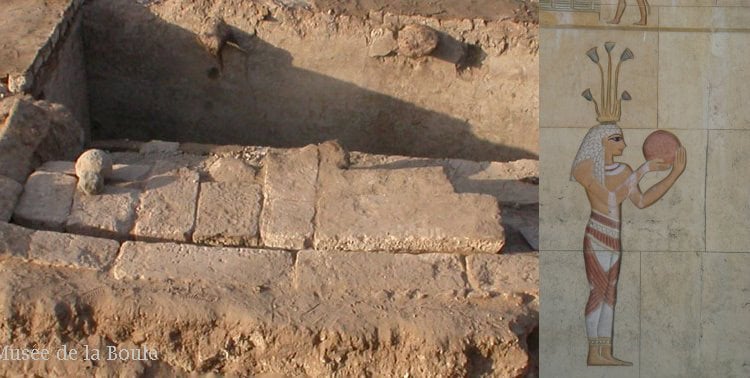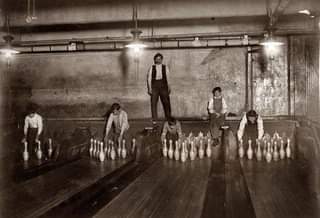Bowling is a popular recreational activity that has a long and rich history. The origins of bowling can be traced back to ancient civilizations in Egypt, Rome, and Greece. In these early societies, people played a variety of games that involved rolling balls or objects at targets, sometimes using their hands and sometimes using implements such as sticks or clubs.
It other circles, it’s been said that Archaeologists have discovered bowling balls, pins, and other related equipment in a tomb of an Egyptian child buried in 5200 B.C. The primitive implements included nine pieces of stone at which a stone “ball” was rolled, the ball having first to roll through an archway made of three pieces of marble.

(Image Credit source: AncientPages.com)
The modern form of bowling, however, is believed to have originated in Germany around the 4th or 5th century. The first recorded mention of bowling in Germany is from a monk named Johannes Tropffke, who wrote about “kegling,” a game that involved rolling a ball at nine pins. The game spread throughout Europe and eventually made its way to the United States in the 19th century, where it became a popular pastime.
Today, bowling is enjoyed by people all over the world and is played in a variety of forms, including ten-pin bowling, nine-pin bowling, and candlepin bowling.
Many actually argue bowling isn’t even a “real sport.”
Who is Johannes Tropffke?
Johannes Tropffke was a monk in medieval Germany who is credited with writing the first recorded mention of bowling. In his writings, he described a game called “kegling,” which involved rolling a ball at nine pins. It is believed that this game was the precursor to modern bowling, which is played with ten pins and a variety of different balls and lanes.
Very little is known about Johannes Tropffke beyond his mention of the game of kegling. It is not clear when he lived or what other accomplishments he may have had. However, his mention of the game in his writings has helped to establish the early history of bowling and its origins in Germany.
When did bowling start in America?
Bowling has a long history in the United States. The first recorded mention of bowling in the United States is from a diary entry made by British soldier Thomas Kekwick in 1733, which described a game of nine-pin bowling being played in New York City.
However, it was not until the 19th century that bowling began to gain widespread popularity in the United States. In the 1840s, the first indoor bowling lanes were built in New York City, and the sport quickly spread to other cities across the country. By the turn of the 20th century, bowling had become a popular pastime and was played in a variety of forms, including ten-pin bowling, nine-pin bowling, and candlepin bowling.
Today, bowling is a well-established and widely popular sport in the United States, with millions of people participating in the sport at various levels of play. It is played in bowling alleys, recreational centers, and other venues across the country and is enjoyed by people of all ages.
What was the first bowling alley in America?
The first indoor bowling alley in the United States is believed to have been built in New York City in the 1840s. Prior to this, bowling was typically played outdoors on makeshift lanes or in small, informal establishments. The construction of the first indoor bowling alley marked a significant milestone in the development of bowling as a popular pastime in the United States.
The first indoor bowling alley was called Knickerbocker Alleys, and it was located in a building on Christopher Street in Manhattan. It was built by John J. McSorley, who owned a tavern on East Seventh Street. The alley was made up of a single lane that was 50 feet long and had a gutter system to collect the balls after they were rolled down the lane.
(Image source: GoBowl on Facebook)
Today, there are thousands of bowling alleys in the United States, and the sport is enjoyed by millions of people at all levels of play. It is played in a variety of forms, including ten-pin bowling, nine-pin bowling, and candlepin bowling, and is an important part of American culture and recreational activity.
What is the oldest public bowling alley?
It is difficult to determine the oldest public bowling alley, as there are many factors that could be considered when determining the age of a bowling alley. Some of the oldest public bowling alleys in the United States include:
Holler House – Milwaukee, Wisconsin: Holler House claims to be the oldest operating bowling alley in the United States. It was built in 1908 and is still in operation today.
Roseland Bowl – Canandaigua, New York: Roseland Bowl is believed to be the second oldest operating bowling alley in the United States. It was built in 1913 and is still in operation today.
Circle Lanes – Lexington, Kentucky: Circle Lanes is believed to be the third oldest operating bowling alley in the United States. It was built in 1913 and is still in operation today.
It is worth noting that these are all ten-pin bowling alleys, and there are other types of bowling alleys that may be older, such as nine-pin bowling alleys or candlepin bowling alleys. It is also possible that there are other public bowling alleys that are older than these, but their ages are not well-documented.
Conclusion
With all the info I found surfing the web, I can tell you this… take what you just read with a grain of salt. Any time you’re talking about the “history” of something, the fact is… you just never really know. We weren’t there in the beginning and most of what you read and hear is just “his” “story.” The past is so long ago and truth will always get mixed in the shuffle. With that said, enjoy the sport for what it is today. 1,000 years from now, who knows how the game will evolve.
I will continue to research and dig up more info and update this post accordingly. Please share any info you may have about the history of bowling. I’m always learning new things but for now, let’s go bowling!

